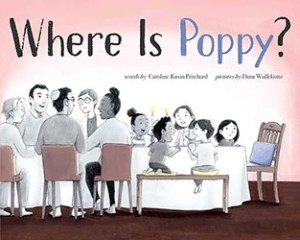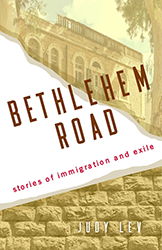Gitty is a happy and optimistic little girl; her friend, Kvetch the owl, is just the opposite. While Gitty sees a beautiful sunny day as full of opportunities, Kvetch warns that fluffy clouds can quickly turn into a menace. In fact, while Gitty sees one cloud as “a gazelle running across the savanna,” Kvetch sees its neighboring cloud as a predatory “lion running toward dinner.” If this were just another children’s picture book about the joys of looking on the bright side of life, it could be grating. Instead, Caroline Kusin Pritchard and Ariel Landy prove that moods can be situational. Even a child as resilient as Gitty can experience despair, and even an owl as negative as Kvetch can cheer up and support his friend.
Landy’s pictures are buoyant, with many bright colors against a background of violet and rose hues. Gitty is not a generic image of joy, but a specific child with dark wavy hair, almond-shaped eyes, and boundless energy. She is also artistic, and her pride in a recently created painting turns to anguish when the rain that Kvetch had predicted becomes a reality. Seeing his friend so upset, Kvetch is suddenly able to summon up coping resources in order to help her. Adding a Jewish dimension to the story, he uses Yiddish words as a humorous arsenal against adversity. Before the disaster, he had called his friend “meshuge” for suggesting that their day would be delightful. Now, with Gitty’s soggy picture apparently ruined, he imaginatively transforms it into a flower vase, a doormat, and a pair of binoculars. After all, the owl observes, “a little bit of … shmuts” is not a crisis; he now admonishes Gitty to stop kvetching and salvage their day together. Less-than-perfect can still be pretty good.
Young readers learn that personalities may not be as fixed as they seem. The most elated child, confronted by disappointment, often feels as powerless as Kvetch. On the other hand, the grumpy little owl turns out to be capable of change. When the book begins, he accompanies Gitty’s exciting predictions with deflating doses of reality. She sees lovely clouds; he interprets them as a sign “to move our tuchuses.” Like the Jewish response to events embodied in the Yiddish language, Kvetch is not wrong. The bad weather, which he correctly predicts, does dampen Gitty’s artwork. Yet, like Yiddish itself, Kvetch is flexible. Disappointment can be transformed into new alternatives. The fact that the book centers this gentle lesson in the context of an ordinary childhood event, not a moment of real trauma, is important. Kvetch the owl may not share Gitty’s intense sense of adventure, but he helps her to understand the importance of having a friend.
Gitty and Kvetch includes a glossary of Yiddish words.
Emily Schneider writes about literature, feminism, and culture for Tablet, The Forward, The Horn Book, and other publications, and writes about children’s books on her blog. She has a Ph.D. in Romance Languages and Literatures.




